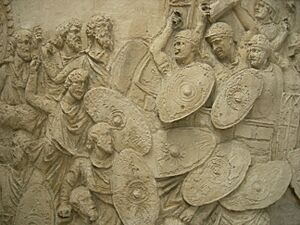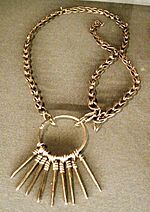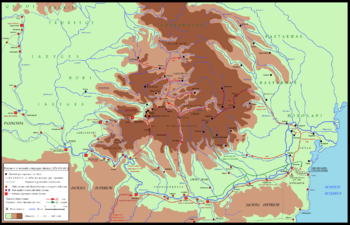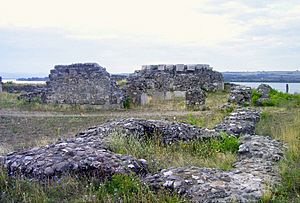Trajan's Dacian Wars facts for kids
Quick facts for kids Trajan's Dacian Wars |
|||||||||
|---|---|---|---|---|---|---|---|---|---|
| Part of the Dacian Wars | |||||||||
 scene on Trajan's Column, possibly describing a battle between legionaries and Dacians. |
|||||||||
|
|||||||||
| Belligerents | |||||||||
Roxolani Buri Bastarnae |
Roman Empire Iazyges |
||||||||
| Commanders and leaders | |||||||||
| Decebalus | Trajan | ||||||||
| Units involved | |||||||||
| Dacian army |
|
||||||||
| Strength | |||||||||
| 200,000 Dacians Germanic and Sarmatian allies |
16 legions (between 150,000 and 175,000 infantry + auxiliary) | ||||||||
| Casualties and losses | |||||||||
| Heavy 500,000 prisoners |
Unknown | ||||||||
Trajan's Dacian Wars (101–102, 105–106) were two military campaigns fought between the Roman Empire and Dacia during Emperor Trajan's rule. The conflicts were triggered by the constant Dacian threat on the Danubian province of Moesia and also by the increasing need for resources of the economy of the Empire.
Background
Throughout the 1st century, Roman policy dictated that threats from neighbouring nations and provinces were to be contained promptly. Dacia had been on the Roman agenda since before the days of Caesar when the Dacians defeated a Roman army at the Battle of Histria.
Domitian's Dacian War had re-established peace with Dacia in 89 AD. However Decebalus used the Roman annual subsidy of 8 million sesterces and craftsmen in trades devoted to both peace and war, and war machines intended to defend the empire's borders to fortify his own defences instead. Despite some co-operation on the diplomatic front with Domitian, Decebalus continued to oppose Rome.
At the time, Rome was suffering from economic difficulties largely brought on by military invasions throughout Europe and in part due to a low gold content in Roman money as directed by Emperor Nero. Confirmed rumors of Dacian gold and other valuable trade resources inflamed the conflict, as did the Dacians' defiant behaviour, as they were "unbowed and unbroken".
However, other pressing reasons motivated them to action. Researchers estimate that only ten percent of barbarians such as Spanish and Gallic warriors had access to swords, usually the nobility. By contrast Dacia had rich resources of iron and copper and were prolific metal workers. A large percentage of Dacians owned swords, greatly reducing Rome's military advantage. Dacia sported 250,000 potential combatants, enough to enable an invasion. It was allied to several of its neighbours and on friendly terms with others that Rome considered enemies. Rome had no concrete defense policy and would not have been able to sustain a war of defense. As such, the new Emperor Trajan, himself an experienced soldier and tactician, began preparing for war. That Dacia was considered a substantial threat can be seen by the fact that Trajan withdrew troops from other borders leaving them dangerously undermanned.
Trajan's First War
After gaining the Senate's blessing for war, by 101 Trajan was ready to advance on Dacia. This was a war in which the Roman military's ingenuity and engineering were well demonstrated. The Roman offensive was spearheaded by two legionary columns, marching straight to the heart of Dacia, burning towns and villages en route. Trajan defeated a Dacian army at the Third Battle of Tapae.
In the winter of 101-2, the Roman army under Trajan had been amassed near the later city of Nicopolis ad Istrum at the junction of the Iatrus (Yantra) and the Rositsa rivers in readiness for the attack by the Sarmatian Roxolani tribe from north of the Danube (who were allied to the Dacians), and resulted in a Roman victory for which the city was named.
In 102 Decebalus chose to make peace once it became clear that the Roman advance towards Sarmizegetusa was unstoppable. The war had concluded with an important Roman victory and with the establishment of a garrison and an acting governor at Sarmizegetusa. A bridge later known as Trajan's bridge was constructed across the Danube at Drobeta to assist with the legionaries' advance. This bridge, probably the biggest at that time and for centuries to come, was designed by Apollodorus of Damascus and was meant to help the Roman army advance faster in Dacia in case of a future war. According to the peace terms, Decebalus got technical and military reinforcement from the Romans in order to create a powerful allied zone against the dangerous possible expeditions from the northern and eastern territories by hostile migrating peoples. The resources were instead used to rebuild Dacian fortresses and strengthen the army. Soon thereafter Decebalus turned against the Romans once again.
Trajan's Second War
Following the first war, Decebalus complied with Rome for a time, but was soon inciting revolt among tribes against them and pillaging Roman colonies across the Danube. True to his intrepid and optimistic nature, Trajan rallied his forces in AD 105 for a second war.
Like the first conflict, the second war involved several skirmishes that proved costly to the Roman military. Faced with large numbers of allied tribes, the legions struggled to attain a decisive victory, resulting in a second temporary peace. Eventually, goaded by the behaviour of Decebalus and his repeated violations of the treaty, Rome again brought in reinforcements, took the offensive and prevailed in 105. The next year they gradually conquered the mountain fortress system that surrounded the Dacian capital, Sarmizegetusa. The final decisive battle took place near the walls of Sarmizegetusa, presumably during the summer of 106, with the participation of the legions II Adiutrix and IV Flavia Felix and a detachment (vexillatio) from VI Ferrata.
The Dacians repelled the first attack, but the Romans, helped by a treacherous local nobleman, found and destroyed the water pipes of the Dacian capital. Running out of water and food the city fell and was razed. Decebalus fled, but was followed by the Roman cavalry and chose to die rather than submit. Nevertheless, the war went on. Thanks to the treason of a confidant of the Dacian king, Bicilis, the Romans found Decebalus's treasure in the river of Sargesia/Sargetia - a fortune estimated by Carcopino at 165,500 kg of gold and 330,000 kg of silver. The last battle took place at Porolissum (Moigrad).
Conclusion and aftermath
The conclusion of the Dacian Wars marked a triumph for Rome and its armies. Trajan announced 123 days of celebrations throughout the Empire. Dacia's rich gold mines were secured and it is estimated that Dacia then contributed 700 million Denarii per annum to the Roman economy, providing finance for Rome's future campaigns and assisting with the rapid expansion of Roman towns throughout Europe. The remains of the mining activities are still visible, especially at Roșia Montană. One hundred thousand male slaves were sent back to Rome; and to discourage future revolts, legions XIII Gemina and V Macedonica were permanently posted in Dacia. The conquered half (southern) of Dacia was annexed, becoming a province while the northern part remained free but never formed a state.
The two wars were notable victories in Rome's extensive expansionist campaigns, gaining Trajan the people's admiration and support. The conclusion of the Dacian Wars marked the beginning of a period of sustained growth and relative peace in Rome. Trajan began extensive building projects and was so prolific in claiming credit that he was given the nickname Ivy. Trajan became an honorable civil leader, improving Rome's civic infrastructure, thereby paving the way for internal growth and reinforcement of the Empire as a whole.
As a consequence of the war, Dacia went through a huge demographic change. In the province of Dacia, out of 3000 identified personal names only 60 were of Dacian, while 2200 were of Roman origin.
...Trajan, after he had subdued Dacia, had transplanted thither an infinite number of men from the whole Roman world, to people the country and the cities; as the land had been exhausted of inhabitants in the long war maintained by Decebalus.
Most of the Dacian population was from now outside Transylvania, known as the Free Dacians, who continuously raided the province allying themselves with the Sarmatians, while the insiders (who were divided up by the Romans to tribes) made at least two rebellions against Roman authority.
See also
- Dacian warfare
- Illyrian Wars
- Roman-Persian Wars
- Marcomannic Wars
- Jewish-Roman wars






